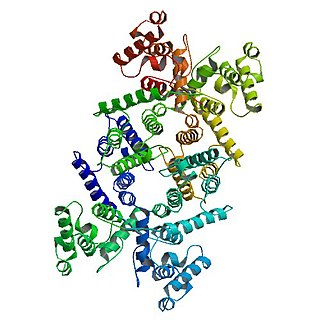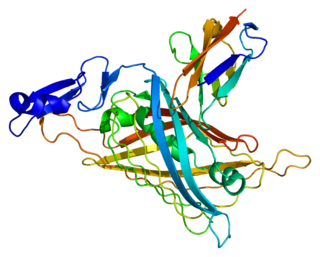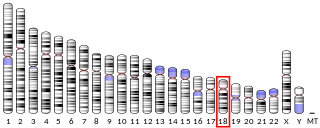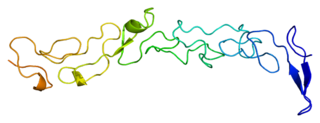
Integrins are transmembrane receptors that facilitate cell-cell and cell-extracellular matrix (ECM) adhesion. Upon ligand binding, integrins activate signal transduction pathways that mediate cellular signals such as regulation of the cell cycle, organization of the intracellular cytoskeleton, and movement of new receptors to the cell membrane. The presence of integrins allows rapid and flexible responses to events at the cell surface.

Smooth muscle is an involuntary non-striated muscle, so-called because it has no sarcomeres and therefore no striations. It is divided into two subgroups, single-unit and multiunit smooth muscle. Within single-unit muscle, the whole bundle or sheet of smooth muscle cells contracts as a syncytium.

Dystrophin is a rod-shaped cytoplasmic protein, and a vital part of a protein complex that connects the cytoskeleton of a muscle fiber to the surrounding extracellular matrix through the cell membrane. This complex is variously known as the costamere or the dystrophin-associated protein complex (DAPC). Many muscle proteins, such as α-dystrobrevin, syncoilin, synemin, sarcoglycan, dystroglycan, and sarcospan, colocalize with dystrophin at the costamere. It has a molecular weight of 427 kDa

Hemidesmosomes are very small stud-like structures found in keratinocytes of the epidermis of skin that attach to the extracellular matrix. They are similar in form to desmosomes when visualized by electron microscopy, however, desmosomes attach to adjacent cells. Hemidesmosomes are also comparable to focal adhesions, as they both attach cells to the extracellular matrix. Instead of desmogleins and desmocollins in the extracellular space, hemidesmosomes utilize integrins. Hemidesmosomes are found in epithelial cells connecting the basal epithelial cells to the lamina lucida, which is part of the basal lamina. Hemidesmosomes are also involved in signaling pathways, such as keratinocyte migration or carcinoma cell intrusion.

Laminins are high-molecular weight proteins of the extracellular matrix. They are a major component of the basal lamina, a protein network foundation for most cells and organs. The laminins are an important and biologically active part of the basal lamina, influencing cell differentiation, migration, and adhesion.

Perlecan (PLC) also known as basement membrane-specific heparan sulfate proteoglycan core protein (HSPG) or heparan sulfate proteoglycan 2 (HSPG2), is a protein that in humans is encoded by the HSPG2 gene.

Dystroglycan is a protein that in humans is encoded by the DAG1 gene.
Originally identified as Kirsten ras associated gene (krag), Sarcospan (SSPN) (is a 25-kDa transmembrane protein located in the dystrophin-associated protein complex of skeletal muscle cells, where it is most abundant. It contains four transmembrane spanning helices with both N- and C-terminal domains located intracellularly. Loss of SSPN expression occurs in patients with Duchenne muscular dystrophy. Dystrophin is required for proper localization of SSPN. SSPN is also an essential regulator of Akt signaling pathways. Without SSPN, Akt signaling pathways will be hindered and muscle regeneration will not occur.
Dystrobrevin is a protein that binds to dystrophin in the costamere of skeletal muscle cells. In humans, there are at least two isoforms of dystrobrevin, α-dystrobrevin and β-dystrobrevin.
The syntrophins are a family of five 60-kiloDalton proteins that are associated with dystrophin, the protein associated with Duchenne muscular dystrophy and Becker muscular dystrophy. The name comes from the Greek word syntrophos, meaning "companion." The five syntrophins are encoded by separate genes and are termed α, β1, β2, γ1, and γ2. Syntrophin was first identified as a dystrophin-associated protein present in the Torpedo electric organ. Subsequently, α-syntrophin was shown to be the predominant isoform in skeletal muscle where it is localized on the sarcolemma and enriched at the neuromuscular junction. The β-syntrophins and γ2-syntrophin are also present in skeletal muscle but also are in most other tissues. The expression of γ1-syntrophin is mostly confined to brain. The syntrophins are adaptor proteins that use their multiple protein interaction domains to localize a variety of signaling proteins to specific intracellular locations. α-Syntrophin binds to nNOS in the dystrophin-associated glycoprotein complex in skeletal muscle cells. There it produces NO upon muscle contraction leading to dilation of the arteries in the local area.

Laminin subunit gamma-2 is a protein that in humans is encoded by the LAMC2 gene.

Laminin subunit alpha-3 is a protein that in humans is encoded by the LAMA3 gene.

Laminin subunit gamma-1 is a protein that in humans is encoded by the LAMC1 gene.

Laminin subunit beta-1 is a protein that in humans is encoded by the LAMB1 gene.

Laminin subunit alpha-2 is a protein that in humans is encoded by the LAMA2 gene.

Alpha-7 integrin is a protein that in humans is encoded by the ITGA7 gene. Alpha-7 integrin is critical for modulating cell-matrix interactions. Alpha-7 integrin is highly expressed in cardiac muscle, skeletal muscle and smooth muscle cells, and localizes to Z-disc and costamere structures. Mutations in ITGA7 have been associated with congenital myopathies and noncompaction cardiomyopathy, and altered expression levels of alpha-7 integrin have been identified in various forms of muscular dystrophy.

Laminin subunit alpha-4 is a protein that in humans is encoded by the LAMA4 gene.

Laminin subunit beta-2 is a protein that in humans is encoded by the LAMB2 gene.
The Akt signaling pathway or PI3K-Akt signaling pathway is a signal transduction pathway that promotes survival and growth in response to extracellular signals. Key proteins involved are PI3K and Akt.

Laminin subunit gamma-3 also known as LAMC3 is a protein that in humans is encoded by the LAMC3 gene.
















